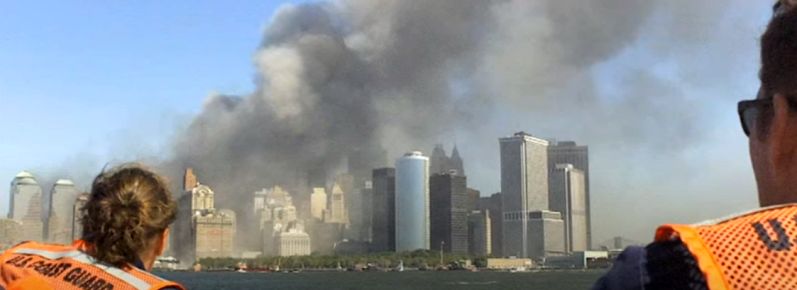 There are moments in history when an individual makes the right choice at exactly the right moment and it makes all the difference. Such was the case with LT. Michael Day on the morning of September 11, 2001, in New York harbor.
There are moments in history when an individual makes the right choice at exactly the right moment and it makes all the difference. Such was the case with LT. Michael Day on the morning of September 11, 2001, in New York harbor.
LT Day was supposed to attend a meeting in the World Trade Center on that clear Tuesday morning in September. Before he arrived, a commercial airliner flew into the World Trade Center’s North Tower. Just over a dozen minutes later, a second plane hit the South Tower. In less than two hours, both buildings would collapse in a maelstrom of fire and debris. New York City’s emergency response center had been in the World Trade Center complex and was buried in the rubble.
When the towers fell, the US Coast Guard lost much of its communications. LT Day was dispatched in a cutter to serve as a “relay to pass information.” What he saw was nightmarish, out of the smoke, myriads of people driven by the fire and ash to the water’s edge, in desperate need of rescue.
At this moment, it could have gone disastrously wrong. The US Coast Guard has a wide range of jobs and responsibilities, both civilian and military, from maritime safety to drug interdiction to combat operations in times of war. It would have been easy for LT. Day or his superiors to fall back on rule-driven procedures, to try to take things by “the book,” even if in this case the “book” simply didn’t apply.
Under normal conditions, the Coast Guard would be expected to take charge of a rescue, but in this case, there were far too many people who needed saving and far too few Coast Guard cutters. Rather than trying to assert control, Day asked for help.
He called out on his VHF radio, “All available boats. This is United States Coast Guard. Anyone wanting to help with the evacuation of Lower Manhattan report to Governor’s Island.”
LT. Day realized that he had a powerful resource in the waters around him — the mariners of New York harbor. They brought special skills and knowledge to the evacuation. Having worked the waterfront, these mariners knew it better than anyone else and that local knowledge was critical. They were also part of a community. They knew and understood each other. Having worked together, they knew that they could rely on one another. And as mariners, they were more than ready to do anything necessary to help those in trouble.
The boat lift was on. More than 100 boats from more than 60 companies responded to LT. Day’s radio call. The evacuees would be carried to safety by ferries, fireboats, tugs, private yachts, dinner and excursion boats — virtually anything that was afloat in the harbor. Before the tumultuous day’s end, an estimated 500,000 people would be evacuated, an evacuation larger than that at Dunkirk in the early days of World War II.
The mariners of New York created a spontaneous and nearly miraculous evacuation as the Coast Guard helped to coordinate. Rather than try to impose order to the rescue, the Coast Guard provided guidance and leadership but largely let what happened happen.
Michael Day, the lieutenant who made the initial radio call, was appointed on-scene commander for the evacuation.
He is now Captain Day, serving as Military Advisor to Secretary, Department of Homeland Security. He previously served as the Deputy Commander, U.S. Coast Guard Sector San Francisco. As such, he led over 800 Coast Guardsmen and 1200 Auxiliarists operating four Cutters, seven Search and Rescue Stations, an Aids to Navigation Team and a Vessel Traffic Service. His area of responsibility included over 2,600 miles of shoreline within the San Francisco Bay and surrounding area.
On this day before the 20th anniversary of the 9/11 boatlift, thank you to all the mariners who participated, and thank you, Captain Day.

Thanks Rick!!
“All available boats…” Thank you Captain Day and all the pilots, skippers, companies who responded to the call. Thanks for the reminder, Old Salt.
Thanks, Rick and all the responders. 🏅 🇺🇲